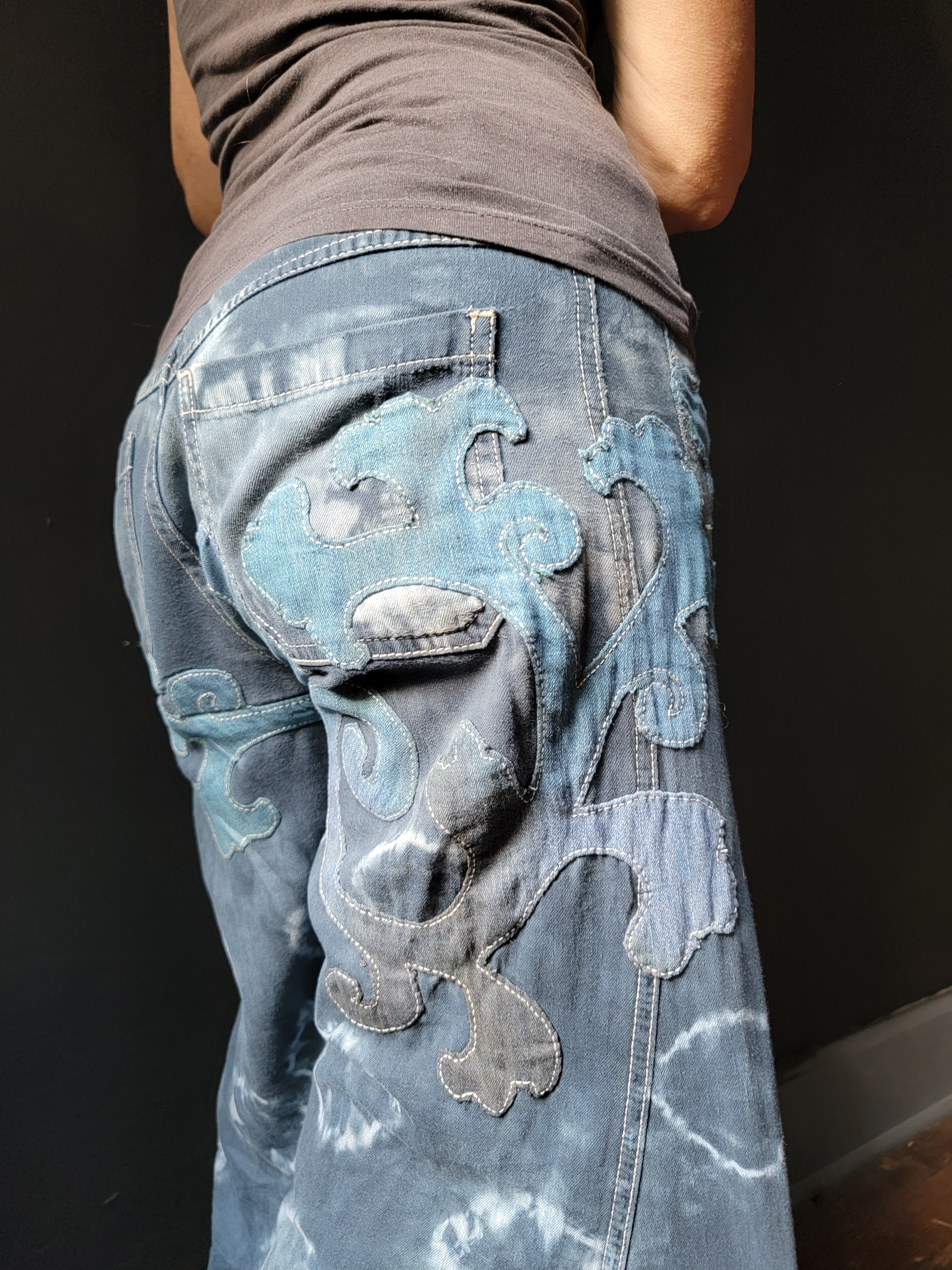Two years ago, I published a post – Little Black Overdress – in which I talked about the fact I decided not to buy anymore clothes. Instead, I would make them myself – sew them by hand. I published that post in October of 2021. Since then, I have made only a few new garments. Mostly I am still wearing what I was wearing then. Things are older, more worn, some threadbare in places, tearing, already torn. My jeans, in particular, need mending. This is a post about mending my jeans.

All of my jeans are the same. They are Free People Extreme Flairs, a style that was discontinued several years ago. They were all, originally, a plain, pale blue, lightweight denim. My friend Rita Petteys (@ritapetteys) dyed them for me; I sent them all to her with only the request that she do ‘something fabulous.’ Each pair she dyed is different. The pair pictured above is the only pair with lozenge-shaped rings of resist where she bound the fabric before dyeing. As my jeans have aged, the fabric has become thin along the center back seam and at the corners of the pockets. So mending can’t be put off any longer.
I started working on a pink pair first, using rectangular patches to cover small holes and thin areas. But I found the rectangles boring, though perfectly functional. So I decided to make spiral-shaped patches that I cut out free-hand. The first one I made looked like it was climbing out of my pocket, which made it feel very cheerful; it helped that it was a bright green. My turned-under edges created the space within the spiral that revealed the shape.
To follow is a speeded-up video of my stitching on one of the spiral patches with another pinned in place but not yet stitched.
From there, I started to experiment with an applique pattern I had developed for another project. My objective was to accomplish the stabilization of existing damage that I needed, pre-empt damage by reinforcing thin areas, and do something ornamental that I would enjoy visually and also enjoy sewing.
The video below tells the story of my shift from spirals to floral appliques and introduces an experiment I tried afterward.
In the experiment I described wanting to try in the video (I outlined my patch shape with a running stitch before cutting it out and attaching it to my jeans), I found that the stay-stitching did not make as big a difference in the curviness of my finished lines as did my practice with the shape.

In the image above, you can see how I traced around my oaktag pattern onto my patch fabric with a fine-tip sharpie. The top blue shape is simply traced. The bottom blue shape is traced then stay-stitched. The shape below has been traced, stay-stitched, and then cut out, ready to attach to a pair of jeans.

I got better at creating a curvy line the longer I worked. Based on that experience, I suggest swatching your full appliques on test fabric or on relatively lower-stakes mending projects before putting them on garments you value and the look of which is important to you.
What all of this jeans-mending has led me to is a methodology for fixing damage and reinforcing weak areas and stress points that is also more than just mending. The patching method I have worked out for myself adds surface embellishment that looks intentionally decorative for its own sake rather than simply functional as repair. I like that. I want that sense of visual interest that is also utilitarian without proclaiming itself, in its form, to be merely practical. My floral and spiral patches take more time than a rectangle to sew onto the jeans. They also add considerable excitement and freshness to what is an ageing cohort of garments that needs to last until I figure out what I’m going to do next for pants.
Here are the steps I took, which can be used for any garment, not just broken jeans:
1. Identify and map the damage
2. Assess salvageability
3. Mend tears and reinforce weak areas – basic stitches and invisible patching
4. Design the visible mend – create decorative patches specific to the damage
5. Applique – basic stitches for pretty patches
6. Embroidery as supplemental surface embellishment and additional reinforcement

